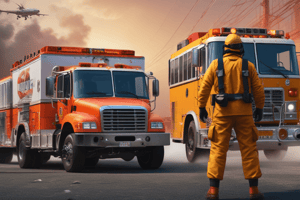Podcast
Questions and Answers
In the US, it is called _______
In the US, it is called _______
HAZMAT
In Canada, it is called _________
In Canada, it is called _________
Dangerous Goods
DOT covers how many hazard classes?
DOT covers how many hazard classes?
9
___________ is a destructive device, expulsive, incendiary, or poison gas bomb, grenade rocket with more than four ounces, missile have an explosion or incendiary charge of more than one quarter ounce (7 grams)
___________ is a destructive device, expulsive, incendiary, or poison gas bomb, grenade rocket with more than four ounces, missile have an explosion or incendiary charge of more than one quarter ounce (7 grams)
What is the EPA definition of toxic chemicals?
What is the EPA definition of toxic chemicals?
In the UN model codes and regulations, hazardous materials are called what?
In the UN model codes and regulations, hazardous materials are called what?
What are the nine transportation hazard classes?
What are the nine transportation hazard classes?
What are the six divisions of Class 1?
What are the six divisions of Class 1?
What are the Class 2 Divisions?
What are the Class 2 Divisions?
What are the Class 3 Divisions?
What are the Class 3 Divisions?
What are the Class 4 Divisions?
What are the Class 4 Divisions?
What are the Class 5 Divisions?
What are the Class 5 Divisions?
What are the Class 6 Divisions?
What are the Class 6 Divisions?
____________ is any material containing radionuclides where both the activity concentration and the total activity in the compound exceed specified values
____________ is any material containing radionuclides where both the activity concentration and the total activity in the compound exceed specified values
____________ is a liquid or solid that causes full thickness destruction of skin at the site of contact within a specified period of time
____________ is a liquid or solid that causes full thickness destruction of skin at the site of contact within a specified period of time
________ is a material that presents a hazard during transport, but it is not molded into another hazard class
________ is a material that presents a hazard during transport, but it is not molded into another hazard class
___________ is a material that presents a hazard during transportation due to its form, quantity, and packaging
___________ is a material that presents a hazard during transportation due to its form, quantity, and packaging
What is the difference between class and division?
What is the difference between class and division?
How many divisions are within DOT Class 1?
How many divisions are within DOT Class 1?
Can mixed loads of hazardous materials be marked?
Can mixed loads of hazardous materials be marked?
Where are common places to find hazardous materials?
Where are common places to find hazardous materials?
What is a common place for HAZMAT incidents?
What is a common place for HAZMAT incidents?
At the awareness level, personnel are supposed to _____________
At the awareness level, personnel are supposed to _____________
_________________ is defined by NFPA 1072, Matter (solid, liquid, or gas) or energy that when released can create harm to people, the environment, and property, including weapons of mass destruction (WMD)
_________________ is defined by NFPA 1072, Matter (solid, liquid, or gas) or energy that when released can create harm to people, the environment, and property, including weapons of mass destruction (WMD)
Flashcards are hidden until you start studying
Study Notes
Introduction to HAZMAT
- In the U.S., hazardous materials are referred to as HAZMAT.
- In Canada, they are classified as Dangerous Goods.
Hazard Classes and Definitions
- The U.S. Department of Transportation (DOT) categorizes hazardous materials into nine classes.
- A weapon of mass destruction (WMD) includes explosive devices that exceed specific weight or charge limits.
- The Environmental Protection Agency (EPA) mandates annual reporting of toxic chemical emissions from specified facilities.
UN and DOT Classifications
- In United Nations regulations, hazardous materials are also termed Dangerous Goods.
- The nine transportation hazard classes encompass:
- Class 1: Explosives
- Class 2: Gases
- Class 3: Flammable Liquids
- Class 4: Flammable Solids
- Class 5: Oxidizers
- Class 6: Poisons
- Class 7: Radioactive materials
- Class 8: Corrosives
- Class 9: Miscellaneous hazardous materials
Class 1 - Explosives Divisions
- Division 1.1: Mass Explosion Hazard
- Division 1.2: Projection Hazard without mass explosion risk
- Division 1.3: Fire Hazard
- Division 1.4: Minor Explosion Hazard
- Division 1.5: Low probability mass explosion hazard (blasting agent)
- Division 1.6: Insensitive articles with no explosion risk
Class 2 - Gases Divisions
- Division 2.1: Flammable Gas (boiling point ≤ 68°F or 20°C)
- Division 2.2: Nonflammable, non-poisonous gases (asphyxiants, oxidizers)
- Division 2.3: Poisonous gases by inhalation
Class 3 - Flammable Liquids
- Flammable liquids encompass materials like gasoline and combustible oils.
Class 4 - Flammable Solids Divisions
- Division 4.1: Flammable solids (includes wetted explosives, self-reactive materials)
- Division 4.2: Spontaneously combustible materials
- Division 4.3: Dangerous when wet, reactive with water
Class 5 - Oxidizers and Peroxides
- Division 5.1: Oxidizers that enhance combustion
- Division 5.2: Organic peroxides containing oxygen in bivalent form
Class 6 - Poisons Divisions
- Division 6.1: Poisonous materials
- Division 6.2: Infectious substances
Class 7 - Radioactive Materials
- Defined as materials with radionuclides exceeding specific activity concentrations.
Class 8 - Corrosives
- Corrosive materials cause full-thickness skin destruction upon contact.
Class 9 - Miscellaneous Hazardous Materials
- Includes materials that pose transport hazards but don’t fit into other classes.
Other Classification Concepts
- Other Regulated Materials are defined as materials presenting hazards based on form, quantity, or packaging.
- Class refers to the primary category, while division represents its subcategory.
Regulations and Awareness
- DOT Class 1 has six specified divisions.
- Mixed loads of hazardous materials cannot be marked for transport.
- Common locations for hazardous materials include gas stations, residential areas, and laboratories.
- HAZMAT incidents commonly occur at port facilities and during floods.
- Personnel at the awareness level must recognize hazards, initiate protective actions, and notify relevant personnel.
Studying That Suits You
Use AI to generate personalized quizzes and flashcards to suit your learning preferences.




